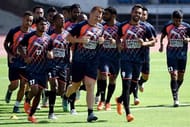The home-and-away league format of the Indian Super League (ISL) presents the opportunity to the participating clubs to build up a home base and utilize their ‘home advantage’. A vociferous home support further lends a distinct flavour to proceedings, and helps make a 90-minute football match a spectacle we all love.
In this regard, the support or rather the lack of it at the home matches of the Delhi Dynamos at the Jawaharlal Nehru Stadium in New Delhi is noteworthy. Despite the emergence of the ISL as the 4th best supported league in the world with respect to average attendances (with average attendances of more than 26,000), the Nehru Stadium saw an average attendance of only about 15,500. This, despite the official capacity of the stadium being over 60,000 after the refurbishment of the stadium for the 2010 Commonwealth Games.
This places the Dynamos 2nd bottom on the list of club average attendances in the ISL with an average attendance of 15,713. This list is propped up by Pune City FC with an average attendance of 7,859 (although in Pune City FC’s defence, their home stadium, the Balewadi Sports Complex in Pune is much smaller).
The organizers have tried their best to attract crowds into stadiums but to little avail – games are marked by firework displays, music and a number of glitzy accessories, thus trying to cater to the whims and fancies of the average Indian sports fan, who is now accustomed to such displays of glamour through the Indian Premier League.
The apparent apathy of the Delhi sporting crowd to come and support their team is not hard to comprehend. As a trend, this has gone on for long. Based on circumstantial evidence, Delhi-based teams in any league competition, be it the Premier Hockey League, the Kabaddi League etc. have never had the expected amount of spectator participation (this author can subscribe to this fact himself, having attended many sporting events in the city, and seen empty stands at most venues). This despite the fact that Delhi boasts of some of the best sporting infrastructure in the country.
The poor performance of Delhi-based teams (including the Dynamos’ disappointing 5th place finish in the ISL last season) can perhaps be attributed to this lack of spectator engagement and the inability of home teams to make their home advantage count.
Looking forward to the new season of the ISL, one hopes that this trend will change. For one, the ISL, as a sporting competition, is a much more settled and visible event now. The Dynamos administration have tried hard to connect with their fan base, which increases the possibility of enhanced attendances this season. Much more is expected of the Dynamos this season, and a boisterous home support would help the Nehru Stadium become a fortress for the Dynamos, easing their path onto a semi-finals berth.

